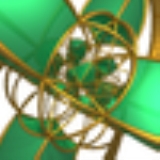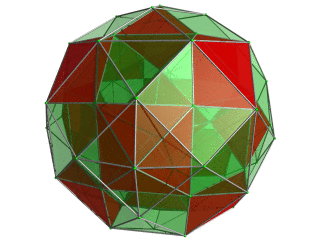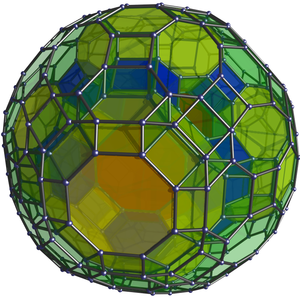
Runcinated 24-cell
Encyclopedia
24-cell |
Runcinated 24-cell |
Runcitruncated 24-cell |
Omnitruncated 24-cell (Runcicantitruncated 24-cell) |
| Orthogonal projections in F4 Coxeter plane | |
|---|---|
In four-dimensional geometry
Geometry
Geometry arose as the field of knowledge dealing with spatial relationships. Geometry was one of the two fields of pre-modern mathematics, the other being the study of numbers ....
, a runcinated 24-cell is a convex uniform polychoron
Uniform polychoron
In geometry, a uniform polychoron is a polychoron or 4-polytope which is vertex-transitive and whose cells are uniform polyhedra....
, being a runcination
Runcination
In geometry, runcination is an operation that cuts a regular polytope simultaneously along the faces, edges and vertices, creating new facets in place of the original face, edge, and vertex centers....
(a 3rd order truncation) of the regular 24-cell.
There are 3 unique degrees of runcinations of the 24-cell including with permutations truncations and cantellations.
Runcinated 24-cell
| Runcinated 24-cell | ||
| Type | Uniform polychoron Uniform polychoron In geometry, a uniform polychoron is a polychoron or 4-polytope which is vertex-transitive and whose cells are uniform polyhedra.... |
|
| Schläfli symbol | t0,3{3,4,3} | |
| Coxeter-Dynkin diagram Coxeter-Dynkin diagram In geometry, a Coxeter–Dynkin diagram is a graph with numerically labeled edges representing the spatial relations between a collection of mirrors... |
||
| Cells | 240 | 48 3.3.3.3 Octahedron In geometry, an octahedron is a polyhedron with eight faces. A regular octahedron is a Platonic solid composed of eight equilateral triangles, four of which meet at each vertex....  192 3.4.4 Triangular prism In geometry, a triangular prism is a three-sided prism; it is a polyhedron made of a triangular base, a translated copy, and 3 faces joining corresponding sides....  |
| Faces | 672 | 384{3} 288{4} |
| Edges | 576 | |
| Vertices | 144 | |
| Vertex figure Vertex figure In geometry a vertex figure is, broadly speaking, the figure exposed when a corner of a polyhedron or polytope is sliced off.-Definitions - theme and variations:... |
 elongated square antiprism Square antiprism In geometry, the square antiprism is the second in an infinite set of antiprisms formed by an even-numbered sequence of triangle sides closed by two polygon caps... |
|
| Symmetry group Coxeter group In mathematics, a Coxeter group, named after H.S.M. Coxeter, is an abstract group that admits a formal description in terms of mirror symmetries. Indeed, the finite Coxeter groups are precisely the finite Euclidean reflection groups; the symmetry groups of regular polyhedra are an example... |
F4, |
|
| Properties | convex Convex polytope A convex polytope is a special case of a polytope, having the additional property that it is also a convex set of points in the n-dimensional space Rn... , edge-transitive |
|
| Uniform index | 25 Cantellated 24-cell In four-dimensional geometry, a cantellated 24-cell is a convex uniform polychoron, being a cantellation of the regular 24-cell.There are 2 unique degrees of runcinations of the 24-cell including with permutations truncations.... 26 27 |
|
In geometry
Geometry
Geometry arose as the field of knowledge dealing with spatial relationships. Geometry was one of the two fields of pre-modern mathematics, the other being the study of numbers ....
, the runcinated 24-cell is a uniform polychoron
Uniform polychoron
In geometry, a uniform polychoron is a polychoron or 4-polytope which is vertex-transitive and whose cells are uniform polyhedra....
bounded by 48 octahedra
Octahedron
In geometry, an octahedron is a polyhedron with eight faces. A regular octahedron is a Platonic solid composed of eight equilateral triangles, four of which meet at each vertex....
and 192 triangular prism
Triangular prism
In geometry, a triangular prism is a three-sided prism; it is a polyhedron made of a triangular base, a translated copy, and 3 faces joining corresponding sides....
s. The octahedral cells correspond with the cells of a 24-cell and its dual.
Coordinates
The Cartesian coordinates of the runcinated 24-cell having edge length 2 is given by all permutations of sign and coordinates of:The permutations of the second set of coordinates coincide with the vertices of an inscribed cantellated tesseract
Cantellated tesseract
In four-dimensional geometry, a cantellated tesseract is a convex uniform polychoron, being a cantellation of the regular tesseract.There are four degrees of cantellations of the tesseract including with permutations truncations...
.
Projections
| 3D perspective projections | ||
|---|---|---|
Schlegel diagram, centered on octahedron, with the octahedra shown. |
 Perspective projection of the runcinated 24-cell into 3 dimensions, centered on an octahedral cell.
|
 Stereographic projection Stereographic projection The stereographic projection, in geometry, is a particular mapping that projects a sphere onto a plane. The projection is defined on the entire sphere, except at one point — the projection point. Where it is defined, the mapping is smooth and bijective. It is conformal, meaning that it... with 24 of its 48 octahedral cells |
Related regular skew polyhedron
The regular skew polyhedronRegular skew polyhedron
In geometry, the regular skew polyhedra are generalizations to the set of regular polyhedron which include the possibility of nonplanar faces or vertex figures....
, {4,8|3}, exists in 4-space with 8 square around each vertex, in a zig-zagging nonplanar vertex figure. These square faces can be seen on the runcinated 24-cell, using all 576 edges and 288 vertices. The 384 triangular faces of the runcinated 24-cell can be seen as removed. The dual regular skew polyhedron, {8,3|3}, is similarly related to the octagonal faces of the bitruncated 24-cell.
Runcitruncated 24-cell
| Runcitruncated 24-cell | ||
| Type | Uniform polychoron Uniform polychoron In geometry, a uniform polychoron is a polychoron or 4-polytope which is vertex-transitive and whose cells are uniform polyhedra.... |
|
| Schläfli symbol | t0,1,3{3,4,3} | |
| Coxeter-Dynkin diagram Coxeter-Dynkin diagram In geometry, a Coxeter–Dynkin diagram is a graph with numerically labeled edges representing the spatial relations between a collection of mirrors... |
||
| Cells | 240 | 24 4.6.6 Truncated octahedron In geometry, the truncated octahedron is an Archimedean solid. It has 14 faces , 36 edges, and 24 vertices. Since each of its faces has point symmetry the truncated octahedron is a zonohedron....  96 4.4.6 Hexagonal prism In geometry, the hexagonal prism is a prism with hexagonal base. The shape has 8 faces, 18 edges, and 12 vertices.Since it has eight faces, it is an octahedron. However, the term octahedron is primarily used to refer to the regular octahedron, which has eight triangular faces...  96 3.4.4 Triangular prism In geometry, a triangular prism is a three-sided prism; it is a polyhedron made of a triangular base, a translated copy, and 3 faces joining corresponding sides....  24 3.4.4.4  |
| Faces | 1104 | 192{3} 720{4} 192{6} |
| Edges | 1440 | |
| Vertices | 576 | |
| Vertex figure Vertex figure In geometry a vertex figure is, broadly speaking, the figure exposed when a corner of a polyhedron or polytope is sliced off.-Definitions - theme and variations:... |
 Trapezoidal pyramid |
|
| Symmetry group Coxeter group In mathematics, a Coxeter group, named after H.S.M. Coxeter, is an abstract group that admits a formal description in terms of mirror symmetries. Indeed, the finite Coxeter groups are precisely the finite Euclidean reflection groups; the symmetry groups of regular polyhedra are an example... |
F4, [3,4,3] | |
| Properties | convex Convex polytope A convex polytope is a special case of a polytope, having the additional property that it is also a convex set of points in the n-dimensional space Rn... |
|
| Uniform index | 28 29 30 | |
The runcitruncated 24-cell is a uniform polychoron
Uniform polychoron
In geometry, a uniform polychoron is a polychoron or 4-polytope which is vertex-transitive and whose cells are uniform polyhedra....
derived from the 24-cell. It is bounded by 24 truncated octahedra
Truncated octahedron
In geometry, the truncated octahedron is an Archimedean solid. It has 14 faces , 36 edges, and 24 vertices. Since each of its faces has point symmetry the truncated octahedron is a zonohedron....
, corresponding with the cells of a 24-cell, 24 rhombicuboctahedra
Rhombicuboctahedron
In geometry, the rhombicuboctahedron, or small rhombicuboctahedron, is an Archimedean solid with eight triangular and eighteen square faces. There are 24 identical vertices, with one triangle and three squares meeting at each. Note that six of the squares only share vertices with the triangles...
, corresponding with the cells of the dual 24-cell, 96 triangular prism
Triangular prism
In geometry, a triangular prism is a three-sided prism; it is a polyhedron made of a triangular base, a translated copy, and 3 faces joining corresponding sides....
s, and 96 hexagonal prism
Hexagonal prism
In geometry, the hexagonal prism is a prism with hexagonal base. The shape has 8 faces, 18 edges, and 12 vertices.Since it has eight faces, it is an octahedron. However, the term octahedron is primarily used to refer to the regular octahedron, which has eight triangular faces...
s.
Coordinates
The Cartesian coordinates of an origin-centered runcitruncated 24-cell having edge length 2 are given by all permutations of coordinates and sign of:The permutations of the second set of coordinates give the vertices of an inscribed omnitruncated tesseract.
The dual configuration has coordinates generated from all permutations and signs of:
Projections
 Schlegel diagram centered on rhombicuboctahedron only triangular prisms shown |
Omnitruncated 24-cell
| Omnitruncated 24-cell | ||
| Type | Uniform polychoron Uniform polychoron In geometry, a uniform polychoron is a polychoron or 4-polytope which is vertex-transitive and whose cells are uniform polyhedra.... |
|
| Schläfli symbol | t0,1,2,3{3,4,3} | |
| Coxeter-Dynkin diagram Coxeter-Dynkin diagram In geometry, a Coxeter–Dynkin diagram is a graph with numerically labeled edges representing the spatial relations between a collection of mirrors... |
||
| Cells | 240 | 48 (4.6.8)  192 (4.4.6) Hexagonal prism In geometry, the hexagonal prism is a prism with hexagonal base. The shape has 8 faces, 18 edges, and 12 vertices.Since it has eight faces, it is an octahedron. However, the term octahedron is primarily used to refer to the regular octahedron, which has eight triangular faces...  |
| Faces | 1392 | 864{4} 384{6} 144{8} |
| Edges | 2304 | |
| Vertices | 1152 | |
| Vertex figure Vertex figure In geometry a vertex figure is, broadly speaking, the figure exposed when a corner of a polyhedron or polytope is sliced off.-Definitions - theme and variations:... |
 Irreg. tetrahedron |
|
| Symmetry group Coxeter group In mathematics, a Coxeter group, named after H.S.M. Coxeter, is an abstract group that admits a formal description in terms of mirror symmetries. Indeed, the finite Coxeter groups are precisely the finite Euclidean reflection groups; the symmetry groups of regular polyhedra are an example... |
F4, |
|
| Properties | convex Convex polytope A convex polytope is a special case of a polytope, having the additional property that it is also a convex set of points in the n-dimensional space Rn... |
|
| Uniform index | 29 30 31 Snub 24-cell In geometry, the snub 24-cell is a convex uniform polychoron composed of 120 regular tetrahedral and 24 icosahedral cells. Five tetrahedra and three icosahedra meet at each vertex. In total it has 480 triangular faces, 432 edges, and 96 vertices.... |
|
The omnitruncated 24-cell is a uniform polychoron
Uniform polychoron
In geometry, a uniform polychoron is a polychoron or 4-polytope which is vertex-transitive and whose cells are uniform polyhedra....
derived from the 24-cell. It is composed of 1152 vertices, 2304 edges, and 1392 faces (864 squares, 384 hexagons, and 144 octagons). It has 240 cells: 48 great rhombicuboctahedra, 192 hexagonal prism
Hexagonal prism
In geometry, the hexagonal prism is a prism with hexagonal base. The shape has 8 faces, 18 edges, and 12 vertices.Since it has eight faces, it is an octahedron. However, the term octahedron is primarily used to refer to the regular octahedron, which has eight triangular faces...
s. Each vertex contains four cells in an irregular tetrahedral vertex figure
Vertex figure
In geometry a vertex figure is, broadly speaking, the figure exposed when a corner of a polyhedron or polytope is sliced off.-Definitions - theme and variations:...
: two hexagonal prism
Hexagonal prism
In geometry, the hexagonal prism is a prism with hexagonal base. The shape has 8 faces, 18 edges, and 12 vertices.Since it has eight faces, it is an octahedron. However, the term octahedron is primarily used to refer to the regular octahedron, which has eight triangular faces...
s, and two truncated cuboctahedra
Truncated cuboctahedron
In geometry, the truncated cuboctahedron is an Archimedean solid. It has 12 square faces, 8 regular hexagonal faces, 6 regular octagonal faces, 48 vertices and 72 edges...
.
Structure
The 48 great rhombicuboctahedral cells are joined to each other via their octagonal faces. They can be grouped into two groups of 24 each, corresponding with the cells of a 24-cell and its dual. The gaps between them are filled in by a network of 192 hexagonal prisms, joined to each other via alternating square faces in alternating orientation, and to the great rhombicuboctahedra via their hexagonal faces and remaining square faces.Coordinates
The Cartesian coordinates of an omnitruncated 24-cell having edge length 2 are all permutations of coordinates and sign of:Projections
| 3D perspective projections | |
|---|---|
 Schlegel diagram |
 Perspective projection into 3D centered on a great rhombicuboctahedron. The nearest great rhombicuboctahedral cell to the 4D viewpoint is shown in red, with the six surrounding great rhombicuboctahedra in yellow. Twelve of the hexagonal prisms sharing a square face with the nearest cell and hexagonal faces with the yellow cells are shown in blue. The remaining cells are shown in green. Cells lying on the far side of the polytope from the 4D viewpoint have been culled for clarity. |

